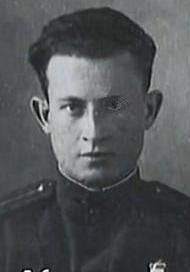
Rakhmiel (Milia) Felzenshtein
Felzenshtein was born in 1923 or 1924 in Kharkov in a traditional Jewish family who were followers of the rebbe of Lubavich. Surreptitiously his parents arranged for him to receive a religious education while he also graduated from a Soviet school.
At the beginning of the war, the family was evacuated from Kharkov to Samarkand. In 1942, Felzenshtein was conscripted into the Red Army and sent to a machine-gun training school. He was appointed as a commander of a machine-gun platoon at the Northern Caucasus in the spring of 1943, with the rank of junior lieutenant. He first saw action in the summer of that year during the liberation of the city of Krasnodar. In the fall, Felzenshtein took part in the landing of the Red Army on the Eltigen peninsula (in the eastern Crimea) with the aim of establishing a bridgehead here. His platoon repulsed twelve enemy counter-attacks. Felzenshtein was a machine-gunner. He and other participants in the landing were awarded the title of Hero of the Soviet Union.
Felzenshtein was seriously injured in the face during this operation and was believed to have been killed. However, by chance a comrade discovered that he was still alive. He spent four months in military hospitals and underwent several operations. In 1944 he returned to the front, with in the rank of lieutenant and as the commander of a company. In May of that year, Felzenshtein was again seriously wounded. Although the surgeons believe this leg would have to be amputated, they were able to save it. Felzenshtein then spent almost a year in military hospital. He was released from the army in September 1944.
After the war, Felzenshtein worked at a textile factory. Despite being a member of the Communist Party, he always tried to observe the commandments of Judaism. In 1974, Felzenshtein submitted a request to emigrate from the USSR to live in the State of Israel. He was the first Hero of the Soviet Union to submit such a request, and this caused a scandal that aroused attention abroad. He was summoned to Kiev, the capital of Ukraine, where the authorities attempted to persuade him to abandon this idea. In the end, he was allowed to emigrate on the conditions that he would leave behind all his Soviet awards and would renounce his title of Hero of the Soviet Union. No information about him appeared in the two-volume Soviet publication Heroes of the Soviet Union, edited by I.N. Shkadov, which was published in 1987-88.
In Israel Felzenshtein lived in Lod, where he worked at a factory. He was one of those chosen to light a torch on Israeli Independence Day of 1975 and on Yom Hashoah (Holocaust Remembrance Day) of 2005.
Felzenshtein died in 2006.
M. Pravdin [a penname], "The Hero of the Landing Operation on the Kerch Peninsula Lieutenant Mulia Felzenshtein", Eynikayt, November 22, 1943. The name of the hero is given incorrectly in this publication.
One of the most heroic operations in the Red Army's recent offensive is, without any doubt, the landing on the Kerch Peninsula […] New Soviet heroes revealed themselves during the operation on the Kerch Peninsula. Among the most courageous of those who excelled with their exceptional courage and fighting efficiency, there are fifty eight officers, sergeants, and rank-and-file soldiers whose heroic deeds earned for these fifty eight knights [vitiazi] the title of Hero of the Soviet Union, the Order of Lenin, and the "Golden Star" medal, all of which were awarded by the Presidium of the Supreme Soviet.
Among these 58, who, as liberators of the Crimea, entered the annals of history forever, [ethnic] Russians are the most numerous. However, there are also representatives of other Soviet ethnic groups. The Jewish people also has a representative among these heroes – Second Lieutenant of the Black Sea Marine Infantry Mulia [sic!] Felzenshtein, who displayed several examples of unparalleled courage.






